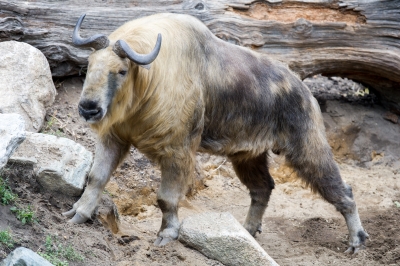
|
Takin look a bit large goats but are actually related to sheep. Takin have short horns and a stocky body, covered with dense brown hair. They live just below the treeline, high in the mountains of the eastern Himalayas and in China. |
The national animals of Bhutan, the takin is a large, stocky hoofed mammal that sometimes is referred to as a goat antelope. Takins have short legs which are supported by large, two-toed hooves. Their large head is made more distinctive by its long, arched nose and stout horns, which are ridged at the base. These horns are present in both sexes and run parallel to the skull before turning upwards to a short point. The long, shaggy coat is light in color with a dark stripe along the back, and males also have dark faces. Their thick wool often turns black in color on their undersides and legs. The overall coloration ranges from dark blackish to reddish-brown suffused with grayish-yellow in the eastern Himalayas to lighter yellow-gray in the Sichuan Province to mostly golden or (rarely) creamy-white with fewer black hairs in the Shaanxi Province.
Takins are found in the eastern Himalayas. They occur in China, Bhutan, India, and Myanmar. These animals live in various habitats ranging from forested valleys to rocky, grass-covered alpine zones.
Takins are live in small family groups of around 20 individuals, although older males may lead a more solitary life. In the summer, herds of up to 300 individuals gather high on the mountain slopes where favorable feeding sites, salt licks, or hot springs are located. Takins are diurnal creatures feeding in the early morning and late afternoon. These animals may even stand on their hind legs to reach leaves that are over 3 m (10 ft) high. They spend the day in dense vegetation and come out into the open only on cloudy or foggy days. When takins are not feeding, they are usually resting. Each spring, takins gather in large herds and migrate up the mountains. During winter when food becomes scarce, takins moves down to lower, more forested and favor sunny spots upon sunrise. When disturbed, takins gives a ‘cough’ alarm call and the herd retreats into thick bamboo thickets and lies on the ground for camouflage.
Takins are herbivorous (folivorous) animals. They feed on a variety of leaves and grasses, as well as bamboo shoots and flowers. Salt is also an important part of their diets, and groups may stay at a mineral deposit for several days.
According to the IUCN Red List, the total population size of the takin is unknown. However, there are estimated populations of the takin subspecies in the following areas: Golden takin in China – 5,069 individuals and Mishmi takin in Tibet – 3,500 individuals. Currently, this species is classified as Vulnerable (VU) on the IUCN Red List and its numbers today are decreasing.
Main threats to takins include overhunting and the destruction of their natural habitat. Timber harvesting, farming, pasture burning, cane and bamboo cutting, road construction, all this have destroyed large areas of takin habitat. Disturbance from tourism, competition, and diseases from domestic livestock pose another serious threat to these animals.
Credit : Anamalia
Picture Credit : Google




